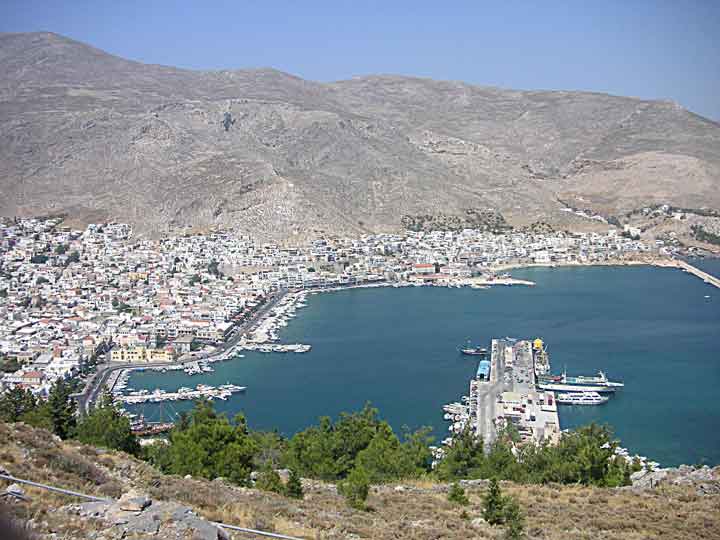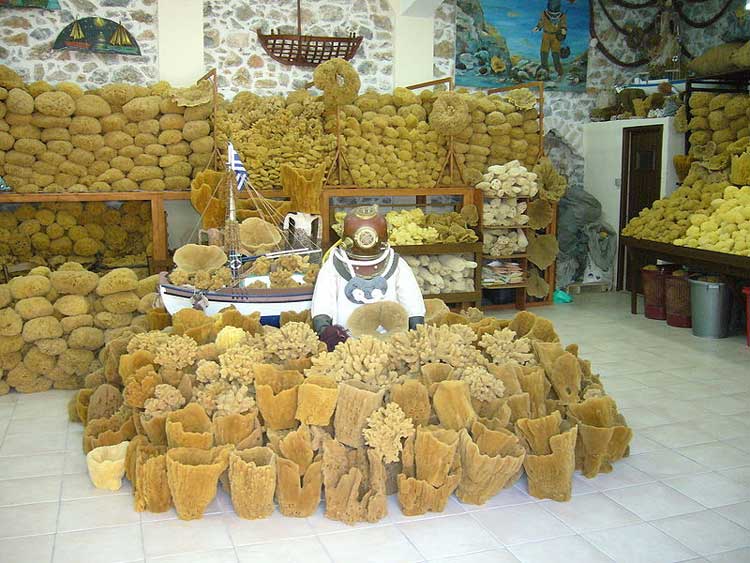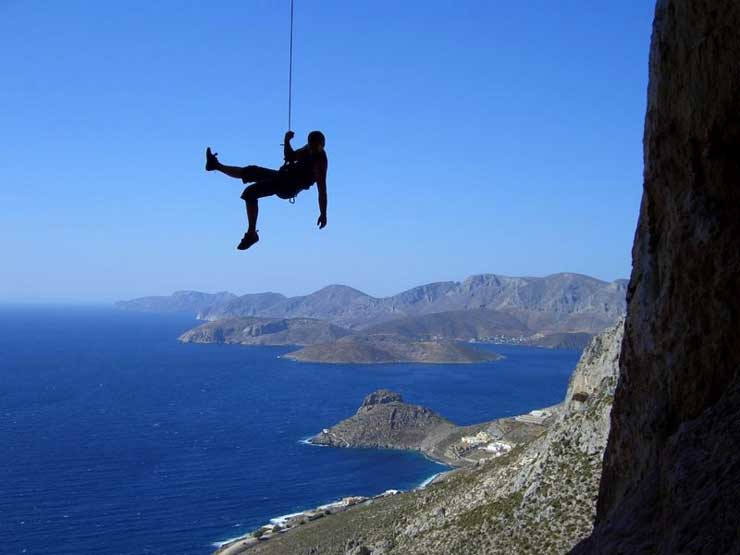.
Administrative Region : North Aegean
Regional unit : Kalymnos
Kalymnos, (Greek: Κάλυμνος) is a Greek island and municipality in the southeastern Aegean Sea. It belongs to the Dodecanese and is located to the west of the peninsula of Bodrum (the ancient Halicarnassos), between the islands of Kos (south, at a distance of 12 km) and Leros (north, at a distance of less than 2 km): the latter is linked to it through a series of islets. Kalymnos lies between two to five hours away by sea from Rhodes. The island is known as Càlino in Italian and Kilimli or Kelemez in Turkish.

In 2001 the island had a population of 16,235, making it the third most populous island of the Dodecanese, after Kos and Rhodes. It is known in Greece for the affluence of much of its population, and also stands both the wealthiest member of the Dodecanese and one of the wealthiest Greek islands overall. The Municipality of Kalymnos, which includes the populated offshore islands of Pserimos (pop. 130), Telendos (54), Kalólimnos (20), and Pláti (2), as well as several uninhabited islets, has a combined land area of 134.544 km² and a total population of 16,441 inhabitants.
Geography
View of Vathy.
The island is roughly rectangular in shape, with a length of 21 km and a width of 13 km, and covers an area of 109 km². Moreover, on the north side there is a peninsula which stretches in a Northwest direction.
Kalymnos is mainly mountainous, with a complicated pattern. There are three main chains going from W-NW to E-SE, and a fourth one which innervates the peninsula. The coastline is very irregular, with many sheltered coves. There are some springs, one among them being thermal. The soil is mainly made of limestone, but in the valleys there is a compact bank of volcanic tuff, relic of an ancient volcano, located near the village of Kantouni. The island is mainly barren, except the two fertile valleys of Vathi and Pothia, where olives, oranges and vineyards grow.
Earthquakes are a frequent occurrence around Kalymnos.
Archipelago of Kalymnos
Kalymnos is neighbored by the small island of Telendos, which was part of Kalymnos, but after a major earthquake 554 AD was split and separated from Kalymnos by a strip of water (about 800 m wide).
Between Kalymnos and Kos there is the islet of Pserimos which is inhabited and, with an area of 11 km², is one of the largest among the lesser islands of Dodecanese. Near Pserimos lies the islet of Platí, and about 5 km to the NE there is the small islet of Kalolimnos.
History
The seafront of Pothia.
The medieval town-castle of Chorio (or Chora).
Emborios in the northernmost part of the island.
Inhabited originally by Carians, during the ancient ages Kalymnos depended on Kos, and followed its history. In the Middle Ages it was Byzantine, and during the 13th century it was used by Venice as a naval base. In 1310 it became a possession of the Knights of Rhodes, and later (mainly in 1457 and 1460) was often attacked by the Ottomans, which conquered it in 1522. Unlike Rhodes and Kos, during the Ottoman period there was no Turkish immigration to Kalymnos.
On May 12, 1912, during the Italo-Turkish War, Kalymnos was occupied by Italian sailors of the Regia Marina. Italy took control of the island along with other islands of the Dodecanese until 1947, when the Dodecansese finally were united with mainland Greece.
Religion
The majority of Kalymnians are Greek Orthodox. The island belongs to that small part of Greece that does not depend on the Church of Greece, but on the Ecumenical Patriarchate of Constantinople based in Istanbul, Turkey. Kalymnos belongs to the Metropolis of Leros, Kalymnos, and Astypalaia.
Sponge Diving/Fishing

Kalymnos (*)
The Sponge of Kalymnos: The usage of sponge was first mentioned in the works of Aristotle and Homer. Since the ancient times, the life and culture of Kalymnos Island was linked to this marine animal; this is the reason Kalymnos is also known as the "Sponge-divers' island". Sponge diving has always been a common occupation on Kalymnos and sponges have been the main source of income of the Kalymnians bringing wealth on the island and making it famous in the Mediterranean.
The first Kalymnian sponge divers used no uniform or equipment and relied mostly on their ability to hold their breath in the sea. The traditional way of sponge-fishing before their replacement by modern technology and special equipment was the harpoon. The new technology allowed spongers to dive in greater depths and stay longer under the water. However, this otherwise positive fact caused the appearance of decompression sickness, also known as the divers' disease or the benz.
The Greek sponge trade was centered close to Dodecanese with Kalymnos being the most prominent for centuries and until mid-80’s, when a disease hit the eastern Mediterranean destroying a great number of sponges and the sponge-fishing industry by extension.
Sponge diving with all its traditions and history still forms the very soul of the people of this island. There is a celebration called Sponge Week taking place on the island each year one week after Easter to honour the relationship between the people of Kalymnos and the sponge, which is also known as the Kalymnian “Gold”. As usual in these occasions, the people sing, dance, and eat traditionally
By long tradition, Kalymnians are known for harvesting sponges from the sea-bed as close as Pserimos or as far as North Africa. Much has been written, sung and filmed about this ancient and dangerous occupation and much more concerning the legendary courage and recklessness of the sponge divers. Today, Kalymnos faces a lack of sponges due to the outbreak of a disease which has decimated sponge crops, although research would indicate that this is not permanent. Sponges are fished individually by hand and it is only a matter of time before the species will replenish the sponge beds and again take their rightful place in the island's economy.

Kalymnos (*)
Economy
Being mostly barren (only 18% of the land can be cultivated), agriculture always played a minor role in the economy of the island, except for the valley of Vathi. The island is famous for its citrus fruits.
Kalymnos owed its past wealth to the sea, mainly with trading and boat building, but the main industry of the island was Sponge fishing. Here the island was the main centre of production in the Aegean, and still now is a traditional occupation with related exhibitions, along with other local folklore, at three local museums.
Another industrial activity typical of Kalymnos was the production of painted head scarfs, which were the most original component of the female dress.
In recent times, tourism has become important for the island, particularly for rock climbing. The island also acquired an airport, the Kalymnos Island National Airport near Pothia in 2006 to better link the island with the mainland.
Since the beginning of the last century there has been a very strong emigration abroad (in 1925 the population amounted to 24,000 inhabitants), especially to the USA and Australia. The cities of Darwin and Melbourne in Australia, and Tarpon Springs in the USA house large Greek communities of Kalymnian descent.
Notable people
Skevos Zervos (1875–1966) surgeon
Nikolaos Vouvalis (1859–1918) sponge trader & kalymnian philanthropist
References
Bertarelli, L.V. (1929) (in Italian). Guida d'Italia, Vol. XVII. Consociazione Turistica Italiana, Milano.
Greece :
| Ancient Greece
Science, Technology , Medicine , Warfare, , Biographies , Life , Cities/Places/Maps , Arts , Literature , Philosophy ,Olympics, Mythology , History , Images Medieval Greece / Byzantine Empire Science, Technology, Arts, , Warfare , Literature, Biographies, Icons, History Modern Greece Cities, Islands, Regions, Fauna/Flora ,Biographies , History , Warfare, Science/Technology, Literature, Music , Arts , Film/Actors , Sport , Fashion --- |
Retrieved from "http://en.wikipedia.org/"
All text is available under the terms of the GNU Free Documentation License


